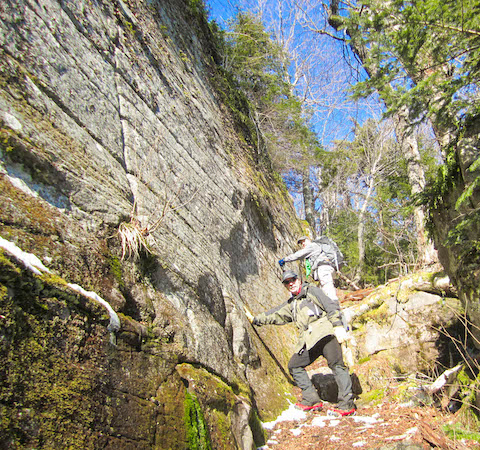Above: Hiking near the the Moonhaw on the Friday and Balsam Cap range in shoulder season conditions in 2012. Photo by Shirley LaPlante.
As October shoulders its way into November, the cool sunny days can easily lull us into a sense of comfortable complacency. Hikers call this time of year the "shoulder season," when the golden days of fall are gone, but full-blown winter isn't quite here.
Most people try to forget about the coming cold, snow, and wind, but the advance of seasons has already begun in the mountains. Everyone enjoys the gift of a mild October or early November day, but rest assured, winter has already begun to lay its icy foundation.
We groan with later dawns and earlier sunsets, getting up in morning gloom and wonder how it got to be so dark in the afternoon. All the while stream and trail water stays frozen for longer and longer until the ice finally sets until the following spring.
When the V's of geese and most of the summer songbirds have departed and bears are looking for a place to snooze, it's time to make adjustments to preparations for a safe and comfortable hike.
When planning a day in the woods, consider that the ambient temperature when it's clear is almost 5.5 degrees colder for every 1,000 feet of elevation change. If the weather forecast predicts a high of 42 degrees near where you live at an elevation of 300 feet, then it will be 31 degrees in the woods where you hike at 2,300 feet. The wet rocks, streams or the previous thaw will now be ice.
By mid-September I've hung up my summer daypack and start carrying the more commodious “beast,” filling it with “twos:” two pairs of hats, two pairs of gloves, two fleeces and the extra contingency stuff of winter.
The lightweight rain shell is put away, replaced by a warmer, heavier soft shell. Two water bottles migrate to the pack, replacing the hydration system whose hose freezes in cold temperatures. The water bottles should be in insulated koozies or wrapped in clothing to keep them from getting too cold. The foam pad that cushioned my summer lunch breaks now insulates and keeps me warm.
You'll probably smile when you see that I carry two headlamps with extra batteries twelve months of the year. But you'd be amazed at how many after-hours rescues result from hikers being benighted without a source of light. A head lamp weighs two to three ounces, frees up your hands and the spare can be lent to a fellow hiker if necessary.
A cold weather tip for all of your electronics: replace your alkaline and rechargeable batteries with lithium batteries. Besides having a longer life, lithium batteries retain most of their power in cold temperatures long after other types begin to fail.

Above: Ralph Ryndak and Alan Via hiking in shoulder season conditions. Photo by Paul Klippel.
Consider a couple of other winter “must-haves” for your shoulder season pack: a pair of adjustable hiking poles. Poles with sharp carbide tips provide stability and balance as the points bite into ice and grab on the frozen surface of rocks. Having the equivalent of four feet instead of two saves many a slip and fall.
Microspikes are one of the best inventions ever devised for slippery trails. These rubber overshoes are equipped with small teeth and when pulled over boots allow you to walk over ice and frozen trails. They have revolutionized cold weather travel in the mountains.
Finally, do your feet a favor and look for a pair of cold-weather boots.
In the meantime, stay warm and stay safe as you enjoy the coming Catskills winter.
Alan Via is the author of “The Catskill 67: A Hiker’s Guide To The Catskill 100 Highest Peaks Under 3,500” and many articles on the Adirondack and Catskill Mountains. He is working on two new hiking guides, and will be writing about snowshoeing in a December 2015 article in the Watershed Post.















